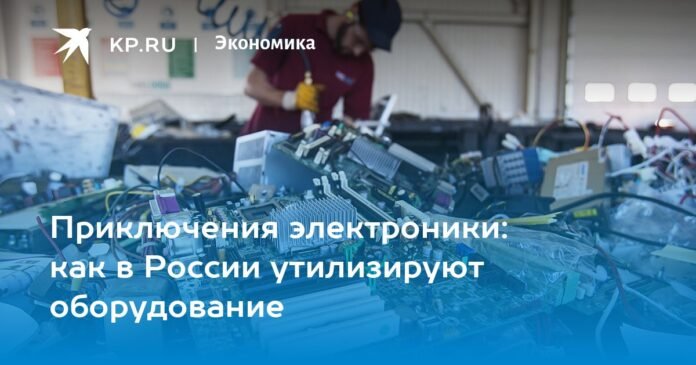USEFUL AND DANGEROUS
In modern Russia, 1.6-1.7 million tons of waste electrical and electronic equipment (EEEE) are generated every year. Gigantic figure! This, for example, is one and a half times more copper mined in the country per year. At the same time, the level of WEEE recycling until 2022 remained quite low: around 5-6%. Alexander Avdonin, senior researcher at the Laboratory for the Study of Problems of Sustainable Development at the Presidential Academy, tells how this industry is developing in Russia today.
E-waste represents approximately 2% of the total MSW volume, but contains the largest variety of hazardous substances. When WEEE ends up in unauthorized landfills or is burned, toxic compounds are formed (dioxins, furans, aromatic carbohydrates, etc.) that pose a threat to ecosystems, life and human health.
The expert points out that waste from electronic and electrical equipment also contains a significant amount of useful components that can be extracted and returned to circulation as secondary raw materials. WEEE contains more than 70 chemical elements (iron, copper, aluminum, lead, cadmium, mercury, titanium, etc., including precious ones), a significant part of which is currently being lost.
Thus, on the one hand, WEEE is a source of valuable components for sectors of the national economy and, on the other, it is a factor of secondary environmental pollution. Therefore, there is a need for control and accounting regarding the management of said waste.
MUST BE DELETED
Little by little, since 2017, the list of waste containing useful components that cannot be recycled and must be recycled has been expanding. Also includes WEEE, for example laptops, notebook computers, smartphones, printers.
On September 1, 2023, new WEEE recycling regulations came into force in the country. Recyclers must use at least 85% of recycled devices and assemblies to obtain products (including shipping them for further processing). At the same time, the degree of its recycling is determined by the possibility of collecting this group of homogeneous waste, i.e. the presence and effectiveness of the extended producer responsibility (EPR) system in the country.
Although the EPR mechanism, according to which the manufacturer and importer of goods are obliged to dispose of products produced or imported into the country at the end of their life cycle after the loss of their consumer properties, was introduced in Russia in 2015 , active training The construction of infrastructure for the collection and centralized processing of WEEE by organizations and the population began recently: according to PPK “REO”, in the last three years, the number of ecological points, shops and other places where they are accepted Electronic waste has tripled in the country: there are now more than 1,400.
“The degree of recycling of electronic products is also gradually increasing, reaching, according to various estimates, between 10% and 15% of the total amount of WEEE generated in 2022, and the collection of environmental fees paid by manufacturers will also increase significantly. if they don’t. get rid of themselves or not cope with it, “clarifies Alexandra Avdonina.
Fast-growing groups of electronic products in recent years include mobile communications and children’s toys containing electronic “filler”, as well as a new direction – electronic cigarettes, with growth rates of more than 30% annually. “These changes in the structure of waste sources must be taken into account when reviewing recycling standards and environmental collection rates, as well as when choosing processing technologies,” comments the expert.
COMBAT PLANNED OBSECTION
The reason for the growth of electronic waste in the world and in our country is the same: an increase in the consumption of electronic and electrical devices associated with scientific and technological progress and the increase in the income of the population. The expert points out that the situation is aggravated by the delay in the collection and recycling rate compared to the growth rate of WEEE, as well as the shortening of the product life cycle, incl. the useful life of electronic and electrical devices due to new models, fashion and planned obsolescence.
“Environmental and cost-effective management of WEEE in Russia is one of the main directions of the transition to a circular economy and is only possible with the introduction of new technological solutions and changes in consumption patterns of goods and services. To improve the legal mechanisms for waste management of electronic and electrical equipment, it is necessary to analyze the effectiveness and risks of implementing initiatives related to the prohibition of reducing the useful life of new versions of products already used on the market, extending the useful life . of household appliances, as well as the requirements for the mandatory production by the manufacturer of components for the repair of equipment during the entire warranty period,” summarizes Alexandra Avdonina.
Even more research on the most current topics on the Presidential Academy telegram channel @ranepa_science

